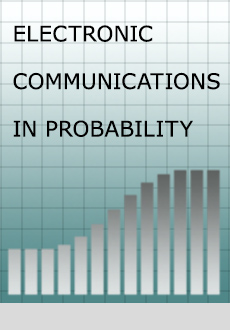Abstract
In the $R$-spread out, $d$-dimensional voter model, each site $x$ of $\mathbb{Z} ^d$ has state (or ‘opinion’) 0 or 1 and, with rate 1, updates its opinion by copying that of some site $y$ chosen uniformly at random among all sites within distance $R$ from $x$. If $d \geq 3$, the set of (extremal) stationary measures of this model is given by a family $\mu _{\alpha , R}$, where $\alpha \in [0,1]$. Configurations sampled from this measure are polynomially correlated fields of 0’s and 1’s in which the density of 1’s is $\alpha $ and the correlation weakens as $R$ becomes larger. We study these configurations from the point of view of nearest neighbor site percolation on $\mathbb{Z} ^d$, focusing on asymptotics as $R \to \infty $. In [RV15], we have shown that, if $R$ is large, there is a critical value $\alpha _c(R)$ such that there is percolation if $\alpha > \alpha _c(R)$ and no percolation if $\alpha < \alpha _c(R)$. Here we prove that, as $R \to \infty $, $\alpha _c(R)$ converges to the critical probability for Bernoulli site percolation on $\mathbb{Z} ^d$. Our proof relies on a new upper bound on the joint occurrence of events under $\mu _{\alpha ,R}$ which is of independent interest.
Citation
Balázs Ráth. Daniel Valesin. "On the threshold of spread-out voter model percolation." Electron. Commun. Probab. 22 1 - 12, 2017. https://doi.org/10.1214/17-ECP80
Information





